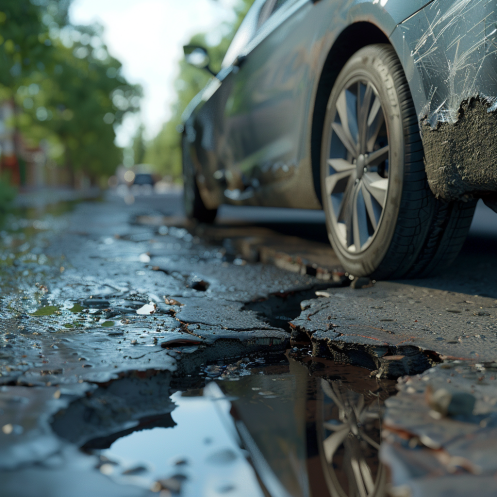Potholes are a common hazard on the road, and hitting one can cause significant damage to your vehicle. Understanding whether your car insurance covers pothole damage is crucial for peace of mind and financial protection.
Table of Contents
What Kind of Damage Can Potholes Cause?
Potholes can cause a variety of damages to your vehicle, including:
- Tire Damage: Blown tires or punctures.
- Wheel Damage: Bent or cracked wheels.
- Suspension Damage: Damaged shocks, struts, or other suspension components.
- Alignment Issues: Misalignment affecting steering and tire wear.
- Body Damage: Scratches, dents, or undercarriage damage.
Does Car Insurance Cover Pothole Damage?
The coverage for pothole damage depends on the type of car insurance policy you have. Here’s a breakdown:
- Comprehensive Coverage: This type of insurance covers non-collision-related incidents, such as theft, vandalism, and natural disasters. Pothole damage can be covered under comprehensive insurance since it’s considered a road hazard.
- Collision Coverage: This insurance covers damages resulting from collisions with other vehicles or objects. Pothole damage can fall under this category because it’s considered a collision with the road. If you have collision coverage, you’re likely covered for pothole damage.
- Liability Coverage: This is the minimum coverage required by law and only covers damages to other people and their property in an accident where you are at fault. Liability insurance does not cover pothole damage to your vehicle.
Steps to Take After Hitting a Pothole
If you hit a pothole and suspect damage to your vehicle, follow these steps to ensure you’re covered:
- Document the Damage: Take photos of the pothole and any visible damage to your vehicle. This will be useful when filing a claim.
- Report the Pothole: Contact your local municipality to report the pothole. This can help others avoid the same fate and might support your claim.
- File a Claim: Contact your insurance provider to file a claim. Provide all necessary documentation, including photos and a repair estimate.
- Get an Estimate: Visit a mechanic or repair shop to get an estimate for the damage repair. Submit this estimate to your insurance company.
Things to Consider
- Deductibles: Remember that filing a claim will involve paying a deductible. Assess whether the repair costs exceed your deductible before deciding to file a claim.
- Premium Increases: Filing a claim might lead to an increase in your insurance premiums. Weigh the cost of repairs against potential premium hikes.
- Policy Limits: Ensure you understand the limits of your policy. Some policies might have specific exclusions or limits for certain types of damage.
Final Thoughts
Understanding your car insurance policy and what it covers can save you from unexpected expenses. Pothole damage can be extensive, but with the right coverage, you can have peace of mind knowing you’re protected. Always review your policy details and consider comprehensive or collision coverage to safeguard against road hazards like potholes.
If you need assistance with your car insurance or have any questions about your coverage, Heritage Insurance is here to help. Contact us today to find out how we can ensure you’re fully protected on the road.

